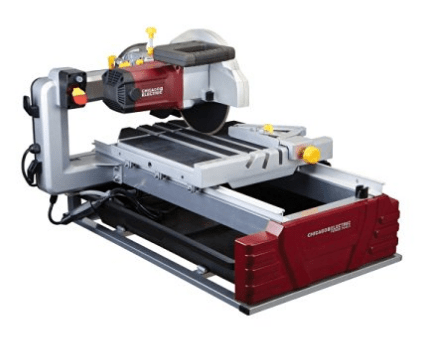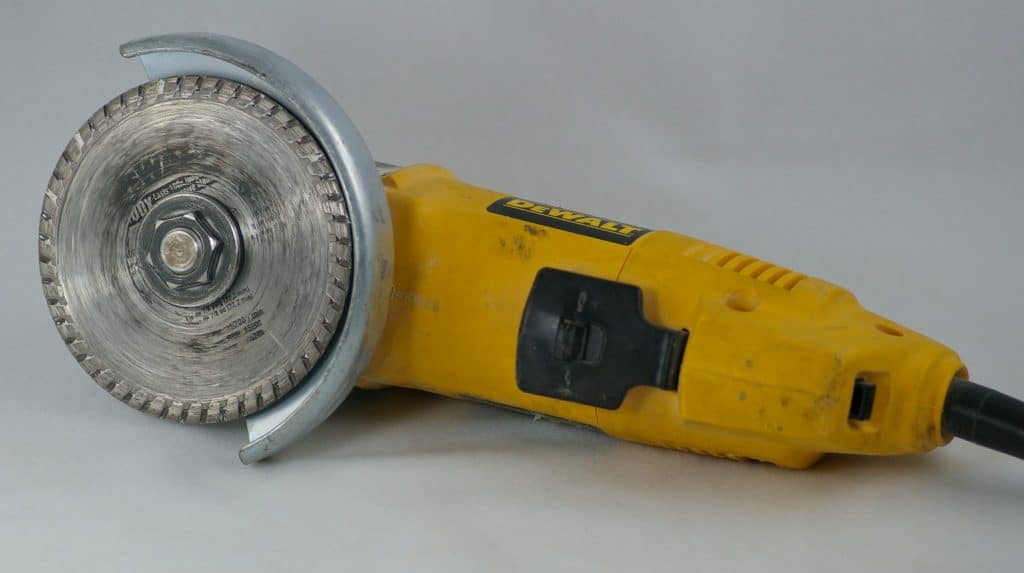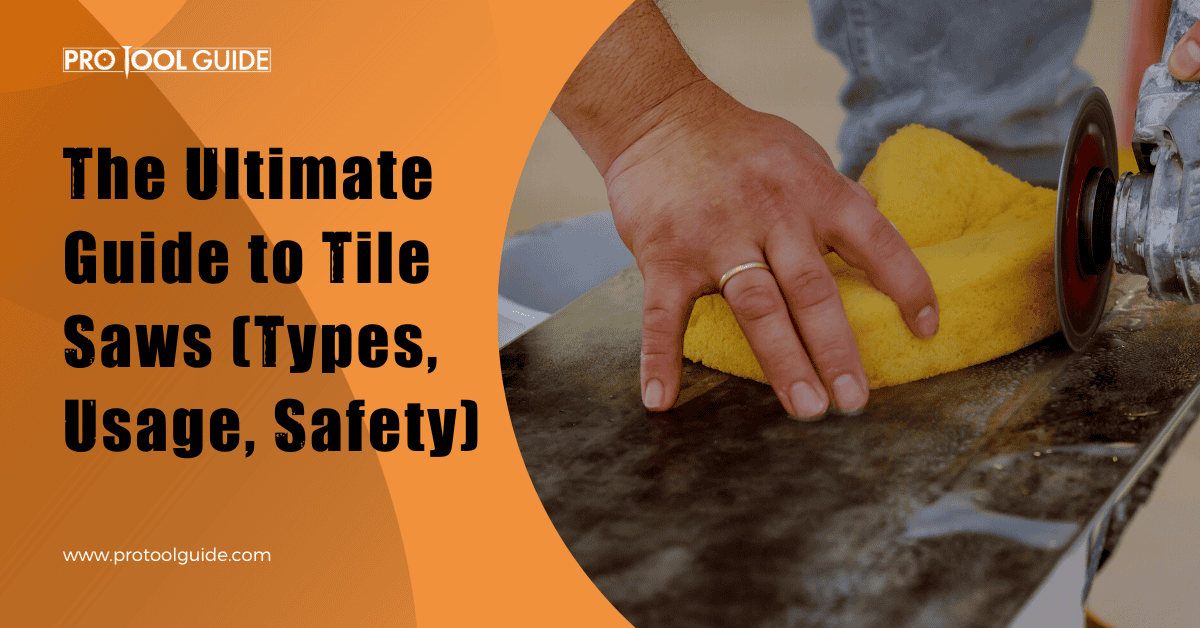Whether you want to redo your bathtub tiles or your kitchen backsplash or even your dining room floor, you will be working with a tile. As you’re likely aware, tile is a great material to use for areas full of crowd and watery surfaces.
A tile saw is the most basic woodworking tool which you probably have heard of. It is very important to learn the basics before using a tile saw to stay safe and be accurate. This guide will teach you all you need to know about tile saws before you get yourselves one.
What is a Tile Saw?
A tile saw is a power tool that uses a water-cooled blade to speed up the task of cutting a tile. A tile saw is best suited for jobs that require special cuts and quite a few of them. Example could be in drainage openings, AC outlets or slant edges.
A tile saw is expensive, cumbersome, tedious and above all, noisy and messy. It usually is not even in the domain of a contractor who does petty jobs and therefore, you can’t use it whenever you want.
Using a wet tile saw is not as easy as it sounds. It is not just any regular cutter through which we can score and tear as it consumes electricity, water and cuts through rotating encrusted diamond blades that give you an exclusive experience.
However, using a tile saw is the professional way to cut a tile, as they don’t involve chirping of the tile which is why the finish is relatively clean with exact specifications.
How Does it Work?

The tile saw comes with a carbide blade that has diamond edges. It cannot be used to cut wood.
Just like an angle grinder, which cuts the tiles and different material by grinding them down with a carbide circular blade, a tile saw works in a similar fashion as well.
If the blades were made of metal with sharp tooth, they would probably corrode easily and have very less impact. The wet tile saw also employs the grinding action which in turn makes the tile cutting task quicker.
Add in the wet tile saw’s continually recirculation “fountain” of water to keep the blade and materials cool and to reduce the dust and flying particles.
Types of Tile Saws
Whether the tile is big or small, you will need a tile saw for precise cuts and quick operation. There are 2 basic types of tile saws which you should be aware of.
Each one of them have their pros and cons and we will discuss each one of them below.
Wet Tile Saws
The best power tool available for cutting tiles is a wet tile saw. It’s blade is mounted into the water and they give the most precise cuts even in the large projects. Even a beginner can make perfect cuts with a very little effort. Just line up and get cutting to make angled, miter or even beveled cuts on almost any material.
It uses water unlike the table saws because it helps to cool down the blade and it acts as a lubricant between the tile and the blade making the operation easier and smoother. It also helps to prevent the dust to settle on the saw.
Handheld Tile Saws
Hand Held or Masonry saws are best suited for small or medium sized woodworking projects. They make the cutting easier through thinner materials like cutting stones for countertops and removing tiles. It’s quite easy to carry them and very easy to operate. All you need to do is just plug in and get started. You can make curved and odd shaped cuts using this type of tile saw.
In general these aren’t very accurate as there is more chance of human error. These should be used outdoors as they are quite messier. They are cheaper than the wet tile saws.
They have 3 sub types which are:
- Dry hand held tile saws: No water required for operation (can heat up if multiple deep cuts are made)
- Wet hand held tile saws: Require water for cuts (come with a 10-12 foot hose)
- Wet/Dry hand held tile saws: Can make cuts with or without water
How to Use a Wet Tile Saw
Wet tile saws usually have the spaghetti outlook about them with all the hoses and pumps which may initially panic you. However, there are wet tile saws in the market which work with the garden hoses and which do not have pumps.
Often, most of us are confronted with the question, “How to use a tile saw?” for some petty jobs like replacing a single tile in the corner of the washroom or if the wet saw can be used to cut any the tile. Wet saw usually can cut all kind of tiles including ceramic, stone, vitrified, porcelain, travertine and even glass.
Some types of tiles may get chipped at the ends. You can apply a gentle pressure to the sides when the tile saw blade is working its way through the last inches.
Also, you can cut odd shaped angles, bevels and small shapes using a wet tile saw. It helps you in avoiding to buy expensive tools like table saws or in hiring professional contractors.
Although it can be a cumbersome process in case you’ve never attempted it before, so here is a beginner’s basic guide to using a tile wet saw.
- First of all, measure and mark the tiles that you need to cut
- Turn the water and fill the tile saw. Make sure that the water is not too much and flowing out so it can splash out of the drain tray. The water should only be free flowing near and around the end of the cutting blade.
- After making sure that it is not splashing out, make sure that your hands are dry before using the wet saw. The water keeps the tile and the blade cool and prevents the chirped particles movement in the air.
- Make sure that the blade is not in contact with anything and your other hand is not on the wet tile saw area and then turn the power.
- Place the tile on the sliding table of the wet tile saw and push it slowly into the blade for it to easily cut the tile.
- As the blade is rotating at maximum speed and the tile is sliding into the blade, water should be copiously flowing over the tile saw blade. This is the most efficient method of how to use a tile saw without any particles flying outside or around in the air.
Read this guide by HomeDit for a detailed explanation on each step.
Best Tile Saw Brands
There are MANY companies that manufacture power tools, but only a FEW that produce quality products since years. You should always go for those companies that have a good track record and products that guarantee high performance. Customer reviews and the longevity of the company should be enough for you to choose.
Below are the brands that I have gone through and are the best in business and known for providing high class products in an optimum cost as well.
DEWALT

DeWalt is a Black & Decker subsidiary which provides the top class and best in quality products. Their products are expensive but are the most reliable and provide unrivalled performance. These are top choices of professional contractors and woodworkers around the world. They design the product by keeping the performance, safety and ease of usage in mind.
Helpful Reviews:
SKIL

If you are on a budget but still want an excellent tile saw, SKIL is the way to go. They build small portable saws and provide outstanding value for the money. They suit best for the DIY homeowners and have some of them as best selling products on Amazon as well.
Helpful Reviews:
QEP

Being for over 30 years in the tile tools market, QEP has been recognised in about 80 countries worldwide. It is known to manufacture portable to heavy duty tile saws with high quality performance. It is constantly producing NEW and innovative products that meet the current challenges.
They have the best inexpensive portable wet tile saws on the market today. It’s tile saws are award winning and you couldn’t go wrong if you choose a QEP tile saw for your projects.
Helpful Review:
Ridgid
They have competitive prices than other leading manufacturers. Ridgid tile saws are used by the pros and the contractors. The best part is that their tile saws come with a full lifetime warranty. They will replace or fix your tile saw free of charge anytime.
Bosch
They produced their first wet tile saw back in 2012 which has been a huge success. It is known for smoothness of it’s operation and ease of usage.
MK
MK is another top tier brand which is well known for it’s superior quality tile saw blades. They are very reliable and best for DIY homeowners or pros.
Chicago Electric

If you have taken up a large tiling job and want to cut through dense porcelain tiles, Chicago Electric is the best choice. It is known for its robust build quality and epic power without breaking a sweat. If you are a professional and experience DIYer, you will find it’s tile saw to be a very good bargain.
Helpful Review:
Where to Buy a Tile Saw?
A consumer has a great advantage of buying a tile saw online even though it can be found on a good amount of local shops.
There are a lot of benefits of buying it through online e-commerce giants like Amazon. The top most reasons being able to read tons of “honest” customer reviews both positive and negative ones. and also there are a lot of discount/exchange options offered by them regularly.
You can even compare the prices with the local shops. This allows you to be certain that you are not being robbed by any.
Who can forget the FREE SHIPPING provided by most of the brands? All these reasons and my personal experience says it’s best to go with the online option.
Check out our buying guide on the best tile saws if you are looking for the best advice on choosing one for yourselves.
So go and shop online to avail the best deals on the latest and best tile saws now!
Top 10 Tile Saw Safety Tips
Be it any power tool, you should always be careful while using it. There are some things you need to take care of while using tile saws in particular, here are those:
- When cutting or handling freshly cut tiles, you should be very cautious as they have very sharp edges. Wearing heavy duty work gloves is the best way to counter this.
- When using a dry tile saw, you should always always and always wear eye protection as without water, there may be debris or pieces of tiles which can fly into our eyes and damage it.
- You don’t want to inhale silica which is a part of the ceramic clay. So always wear a NIOSH approved mask rated type N-95 or higher when cutting any tile3.
- When using a wet tile saw, you should be very careful while dealing with the electrical equipments/tools. Have an optimum number of those tools nearby with a good amount of distance between any two.
- The drop loop is lower than both the saw and the outlet, which prevents the water to drip down the electric cord into the outlet.
- Don’t be a cavalier about wearing the safety glasses while using the wet saw. If you’re so curious about how to cut a glass tile with a wet saw, not wearing glasses will only make you end up being blind.
- In case where the water is splashing out, don’t use the blade as you can end up injuring yourself by junking the blade up, breaking both the tile and the blade. However, the individual procedure might differ with each specific tile as they are all different in nature.
- Make sure the mask is fresh new and the tile blade is clean before using
- Use a quality extension cord while operating a tile saw, since they use a lot of power and it could melt low quality wires
- Do have a first-aid kit nearby your workplace. It is always helpful in emergency cases.
Therefore, it is important to take necessary safety measures while cutting a tile with a wet tile saw as it is an intimidating process that most of us are not familiar with.
However, because of the heavy use and the traffic functionality of the tile, keeping it neat and precise will enhance the beauty of the space and what’s better than a wet saw for a straightforward and efficient tile cutting?
Best Alternatives to Tile Saws
There are a few alternatives which you can use if you don’t want to use a tile saw. However I hope by now you must know that it helps to make the most precise and quality cuts.
Below are the 4 options which you can go for:
Snap Tile Cutters
A snap tile cutter is advanced but is impeccable. However, it’s more of a bench tool which requires investment and buy it only when you’re going to use it for multiple jobs as you can’t find a more viable choice to the wet saw. It can make cuts upto 12 inches at a much lower cost. However there can be uneven breaks which is rarely the case while using a tile saw.
Pro tip : A wet saw will cost than a table saw so if you have just one room to tile, I would advise you not to buy a tile saw but rent one or just use a snap cutter instead.
For more than one room or projects, it would be a good idea to buy a budget friendly tile saw. It is important to realise that unlike a reciprocating saw that has multiple uses, a tile saw can only cut tiles.
Helpful Guide:
Tile Nippers

Nippers are cheap and also portable. They are manually operated and therefore doesn’t need the electric supply which makes them less useful. They are ideal to work in a quiet environment without creating a disturbance to the neighbourhoods.
However, they are not as precise as a wet tile saw, and you should give an extra finish after the cutting. Wrap the tile in a rag before cutting and then cut the edge away using the nipper. Now, take a chip out of the external edge and remove the center of the tile edge. Keep repeating till you approach the marked line gaining gradual control over the shape.
Angle Grinders
Grinders are great for cutting the irregular shapes and circular shapes. Place a compass at the centre of the tile and carve a circle inside the edges. In cases where you can’t make a circle, make a semi-circle against the tile edge.
Hold the level over the top and cut the outside edge of the circle and give them a finish using a rasp or sandstone. You can also try passing the tile on the stone veneers to level the irregularities.
Tile Scribe

This tool can score any tile after tipping it in tungsten carbide. It involves marking the shape of the tile, laying another tile across this. Once you’re done with the two steps, press the cutter firmly and score along the mark from the start to the end to avoid any overhanging.
Conclusion
A tile saw can be your best companion if you DIY at home. It has the ability to cut the tiles easily and make sure the finishing is awesome.
This guide in my opinion is the best out there on the web. I tried to create the one stop resource for all you woodworkers. So do let me know if you liked it and also share if you think it can help a fellow woodworker.
I will try to keep this updated with the latest tips as well. So keep checking back for new information.
Lastly, thanks for reading this as I have worked a lot to create this guide for you all, I hope you enjoyed it!
